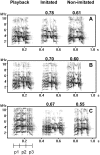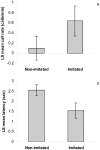Vocal imitation in parrots allows addressing of specific individuals in a dynamic communication network
- PMID: 23185424
- PMCID: PMC3504101
- DOI: 10.1371/journal.pone.0049747
Vocal imitation in parrots allows addressing of specific individuals in a dynamic communication network
Abstract
Parrots in captivity are known for their ability to vocally imitate humans and recently it has been shown that wild-living orange-fronted conures are able to immediately imitate other individuals' contact calls. The function of this exceptional ability to imitate remains unclear. However, orange-fronted conures live in fission-fusion flocks where they encounter many different individuals every day, and it is possible that their vocal imitation ability is a flexible means to address a specific individual within a flock. We tested this via playback to short-term captive wild conures. Test birds were placed together in pairs in outdoor aviaries to form simple flocks. To simulate imitation of a specific individual these pairs received playback of contact calls that primarily imitate one of the two birds. Overall, individuals that received simulated vocal imitations of its calls responded more frequently and faster than the other individual. This suggests that orange-fronted conures can use imitations of contact calls to address specific individuals of a flock. In the discussion we argue that the fission-fusion flock dynamics of many parrot species has been an important factor in evolving conures' and other parrots' exceptional ability to imitate.
Conflict of interest statement
Figures




Similar articles
-
Vocal matching by orange-fronted conures (Aratinga canicularis).Behav Processes. 2009 Oct;82(2):133-9. doi: 10.1016/j.beproc.2009.05.005. Epub 2009 Jun 6. Behav Processes. 2009. PMID: 19501135
-
Follow the leader? Orange-fronted conures eavesdrop on conspecific vocal performance and utilise it in social decisions.PLoS One. 2021 Jun 9;16(6):e0252374. doi: 10.1371/journal.pone.0252374. eCollection 2021. PLoS One. 2021. PMID: 34106975 Free PMC article.
-
Sex-specific responses to vocal convergence and divergence of contact calls in orange-fronted conures (Aratinga canicularis).Proc Biol Sci. 2008 Sep 22;275(1647):2147-54. doi: 10.1098/rspb.2008.0517. Proc Biol Sci. 2008. PMID: 18522908 Free PMC article.
-
Convergence of calls as animals form social bonds, active compensation for noisy communication channels, and the evolution of vocal learning in mammals.J Comp Psychol. 2008 Aug;122(3):319-31. doi: 10.1037/a0013087. J Comp Psychol. 2008. PMID: 18729661 Review.
-
Vocal Communication in Hummingbirds.Brain Behav Evol. 2022;97(3-4):241-252. doi: 10.1159/000522148. Epub 2022 Jan 24. Brain Behav Evol. 2022. PMID: 35073546 Review.
Cited by
-
A multidimensional approach to the self in non-human animals through the Pattern Theory of Self.Front Psychol. 2025 Apr 9;16:1561420. doi: 10.3389/fpsyg.2025.1561420. eCollection 2025. Front Psychol. 2025. PMID: 40271366 Free PMC article.
-
Communication in bottlenose dolphins: 50 years of signature whistle research.J Comp Physiol A Neuroethol Sens Neural Behav Physiol. 2013 Jun;199(6):479-89. doi: 10.1007/s00359-013-0817-7. Epub 2013 May 7. J Comp Physiol A Neuroethol Sens Neural Behav Physiol. 2013. PMID: 23649908
-
Social calls provide novel insights into the evolution of vocal learning.Anim Behav. 2016 Oct;120:163-172. doi: 10.1016/j.anbehav.2016.07.031. Epub 2016 Sep 7. Anim Behav. 2016. PMID: 28163325 Free PMC article.
-
Vocal dialects in parrots: patterns and processes of cultural evolution.Emu. 2018;118(1):50-66. doi: 10.1080/01584197.2017.1379356. Epub 2017 Oct 20. Emu. 2018. PMID: 29962561 Free PMC article.
-
What constitutes "social complexity" and "social intelligence" in birds? Lessons from ravens.Behav Ecol Sociobiol. 2019;73(1):12. doi: 10.1007/s00265-018-2607-2. Epub 2019 Jan 19. Behav Ecol Sociobiol. 2019. PMID: 30930524 Free PMC article. Review.
References
-
- McGregor PK, Dabelsteen T (1996) Communication networks. In: Kroodsma DE Miller EH, eds. Ecology and Evolution of Acoustic Communication in Birds. Ithaca: Cornell University Press. 409–425.
-
- Dabelsteen T, McGregor PK (1996) Dynamic acoustic communication and interactive playback. In: Kroodsma DE Miller EH, eds. Ecology and Evolution of Acoustic Communication in Birds. Ithaca: Cornell University Press. 398–408.
-
- Patricelli GL, Dantzker MS, Bradbury JW (2008) Acoustic directionality of red-winged blackbird Agelaius phoeniceus song relates to amplitude and singing behaviours. Animal Behaviour 76: 1389–1401.
-
- Falls JB, Krebs JR, McGregor PK (1982) Song matching in the great tit Parus major: the effect of similarity and familiarity. Animal Behaviour 30: 977–1009.
-
- Krebs JR, Ashcroft R, Orsdol Kv (1981) Song matching in the great tit Parus major . Animal Behaviour 29: 918–923.
Publication types
MeSH terms
LinkOut - more resources
Full Text Sources

